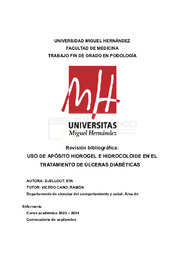Abstract:
La diabetes mellitus es una enfermedad crónica que puede causar
complicaciones graves, como el "pie diabético", caracterizado por la presencia de
úlceras en los pies. Estas úlceras, si no se tratan adecuadamente, pueden llevar a
amputaciones. Existen diversos sistemas de clasificación y tratamientos para las
úlceras, como los apósitos de hidrocoloide e hidrogel, que promueven la
cicatrización al mantener un ambiente húmedo. Este trabajo revisa la literatura
sobre la clasificación y el tratamiento de las úlceras en el pie diabético.
Objetivos: Comparar los apósitos de hidrogel con los de hidrocoloide para
determinar cuál es el más eficaz en el tratamiento de úlceras diabéticas,
considerando parámetros como la velocidad de cicatrización, la reducción de
infecciones y la mejora del lecho de la úlcera.
Metodología: Se realizaron búsquedas sistemáticas en las bases de datos
PubMed, Embase y Redalyc hasta el 5 de julio de 2024, incluyendo todos los
artículos científicos que abordan el uso de apósitos de hidrogel e hidrocoloide para
tratar úlceras en pacientes con diabetes.
Resultados: Un total de 9 artículos fueron incluidos en esta revisión, abarcando
diferentes tipos de revisiones, ensayos, estudios de casos y análisis de redes
bayesianas. Los artículos evaluaron la eficacia de los apósitos considerando
parámetros como la velocidad de cicatrización, la reducción de infecciones y la
mejora del lecho de la úlcera. Todos los artículos mostraron resultados favorables al
uso de apósitos de hidrogel en úlceras diabéticas, salvo uno que presentó una
conclusión limitada sobre el uso de hidrogel debido a múltiples restricciones.
Conclusión:La revisión mostró que los apósitos de hidrogel son altamente efectivos
en el tratamiento de las úlceras del pie diabético. En comparación, hay una falta de
estudios que evalúen el uso de apósitos de hidrocoloide en úlceras diabéticas.
Diabetes mellitus is a chronic disease that can lead to severe complications, such as
"diabetic foot," characterized by the presence of ulcers on the feet. These ulcers, if
not treated properly, can lead to amputations. There are various classification
systems and treatments for ulcers, such as hydrocolloid and hydrogel dressings,
which promote healing by maintaining a moist environment. This paper reviews the
literature on the classification and treatment of diabetic foot ulcers.
Objectives: To compare hydrogel dressings with hydrocolloid dressings to
determine which is more effective in treating diabetic ulcers, considering parameters
such as healing speed, infection reduction, and improvement of the ulcer bed.
Methodology: Systematic searches were conducted in the PubMed, Embase, and
Redalyc databases up to July 5, 2024, including all scientific articles addressing the
use of hydrogel and hydrocolloid dressings to treat ulcers in diabetic patients.
Results: A total of 9 articles were included in this review, covering various types of
reviews, trials, case studies, and Bayesian network analyses. The articles evaluated
the effectiveness of the dressings based on parameters such as healing speed,
infection reduction, and improvement of the ulcer bed. All articles showed favorable
results for the use of hydrogel dressings in diabetic ulcers, except for one article that
presented a limited conclusion on hydrogel use due to numerous limitations.
Conclusion: The review showed that hydrogel dressings are highly effective in
treating diabetic foot ulcers. In comparison, there is a lack of studies evaluating the
use of hydrocolloid dressings in diabetic ulcers.
|
 La licencia se describe como: Atribución-NonComercial-NoDerivada 4.0 Internacional.
La licencia se describe como: Atribución-NonComercial-NoDerivada 4.0 Internacional.
.png)
